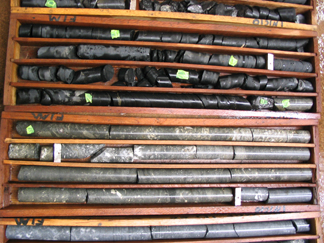 Hundreds
of millions of years ago, a carapace of ice may have periodically covered the
entire planet. This “Snowball Earth” would have been an extremely
hard place to live. New research, however, indicates that microbes seem to have
thrived in certain places that they should not have during that time, leading
some scientists to conclude that the snowball was more slushy than frozen solid.
Hundreds
of millions of years ago, a carapace of ice may have periodically covered the
entire planet. This “Snowball Earth” would have been an extremely
hard place to live. New research, however, indicates that microbes seem to have
thrived in certain places that they should not have during that time, leading
some scientists to conclude that the snowball was more slushy than frozen solid.One of the cores shown here (middle left), taken from a mine in Brazil, held a dropstone that could only have been deposited by a glacier, at a time when Earth may have been completely frozen over. Researchers are using fossils of microorganisms from these cores to argue that the planet’s icy shell would have to have been slushy in parts to support the life forms. Image courtesy of Alison Olcott.
Geologic evidence shows that glaciations occurred several times, millions of years apart during the Neoproterozoic, around 800 to 550 million years ago. According to one version of the Snowball Earth hypothesis, the planet could have had kilometers’ thick layers of ice even in the tropics, which would have precluded photosynthesis and kept life limited to tiny pockets on the planet. Challenging that idea are recent microbe findings by Alison Olcott of the University of Southern California in Los Angeles and her co-workers.
Olcott’s team took samples from a succession of 740- to 700-million-year-old shale and carbonate rocks in Brazil, in which they found evidence of glacial activity throughout the layers, including a mineral that forms in organic-rich mud. They also found organic matter that could only have been produced by microbes using photosynthesis or from sulfate-reducing bacteria, which do not need oxygen to “breathe.” The evidence indicates a diverse community of microbes that lived with and without oxygen, and the assemblage did not differ from layers before and after that Neoproterozoic time period.
The evidence “doesn’t debunk glaciation itself,” Olcott says, but it does support a more slushy snowball. With a “hard” snowball, “there’s no way these rocks would have been deposited” in such massive thicknesses, covering such a long period of time, she says.
The rocks are instead associated with ice-free or thin-ice conditions, the researchers conclude. Environments at the edge of ice “with a band of open water could have life zones extending up into the ice that are quite productive,” Olcott says. Her team will continue to look for other “refugia” with evidence of abundant life, to show that the Brazil deposits are not a rarity.
Past models have indicated that keeping ice at the planet’s equator would be difficult, and other geologic strata confound the proposal of massive thicknesses of ice covering the entire globe. Even so, thriving microbial communities are not the final blow to the hard snowball hypothesis, says Warwick Vincent, an Arctic microbiologist at Laval University in Québec City, Canada.
Vincent says that eliminating the idea of a totally frozen Earth may not be possible. Instead, this new work “underscores the potential for complex life” to survive “pretty severe environments,” including extreme cold and very low light conditions (at depth in the ocean or permafrost), he says. Recent research has found abundant microbes in modern-day icy environments, where communities thrive or go dormant for long periods of time to survive intense freezing — for example, under sea ice in the Antarctic’s Ross Sea.
In particular, green sulfur bacteria (one type of microbe Olcott and co-workers found), associated with microbial mats, are very active in today’s polar settings, despite prolonged periods of freezing. The microbes don’t need oxygen but photosynthesize using hydrogen sulfide, and, when “briefly exposed to liquid water, light and nutrients, whole ecosystems take off for a short period of time,” Vincent says.
Brent Christner of Montana State University in Bozeman says that Olcott’s team’s new findings present two possible explanations: Either “life may be tougher than suspected,” he says, or the Snowball Earth scenario “is not as extreme as originally thought.”

